Do you love hot sauce but find yourself wondering just how spicy that new bottle really is? Determining the true heat level of hot sauces can be confusing. Some are mild, while others make your mouth feel like it’s on fire!
Luckily, there are a few simple ways to test the Scoville rating of any hot sauce so you know exactly what you’re getting into before dousing your food. In this article, I’ll explain the Scoville scale and walk you through the methods you can use at home to put any sauce to the test. You’ll be able to precisely gauge the level of heat and find the perfect hot sauce to match your tolerance.
The Scoville scale was created in 1912 by chemist Wilbur Scoville as a way to measure the pungency or “spicy heat” of chili peppers and hot sauces. The scale rates the capsaicin content in Scoville Heat Units (SHU), with higher numbers meaning more heat.
Here are three basic methods you can use to assess any hot sauce:
- Dilute the sauce and taste it. This organoleptic test will give you a sense of the heat level based on your own reaction.
- Use a Scoville meter or tester. These devices measure capsaicin content chemically.
- Send the sauce to a lab for high-performance liquid chromatography testing. This gives the most precise Scoville rating.
Now that you’re armed with the knowledge of how to test the intensity of any hot sauce, you can easily determine if you can handle the heat. Time to put your taste buds to the test!
What is the Scoville Scale?
The Scoville scale is the standard for measuring the pungency or “spicy heat” of chili peppers and hot sauce. It was created in 1912 by American chemist Wilbur Scoville to quantify the amount of capsaicin in a pepper.
Capsaicin is the chemical compound in chilies that stimulates our nerve endings and produces that fiery, burning sensation. The higher the concentration of capsaicin, the hotter the pepper or sauce will taste.
The Scoville scale measures the spicy heat in Scoville Heat Units (SHU). The ratings work on a scale from 0 to over 3 million SHU, with higher numbers denoting more intense heat.
Breakdown of Scoville Scale Ratings
- 0-700 SHU – Not spicy/minimal heat
- 700-3,000 SHU – Mildly spicy
- 3,000-25,000 SHU – Moderately spicy
- 25,000-70,000 SHU – Very spicy
- 70,000-350,000 SHU – Extremely spicy
- 350,000-1 million SHU – Dangerously hot
- Over 1 million SHU – Hot enough to cause physical harm
To put this into perspective, a jalapeño pepper has a Scoville rating around 2,500-10,000 SHU, while the infamous ghost pepper is over 1 million!
Testing Methods for Scoville Level
There are a few different methods you can use at home or by sending samples to a lab in order to determine the Scoville heat rating of a hot sauce.
Organoleptic Testing
This simple method was the original way Scoville measured pepper heat himself back in 1912.
To do an organoleptic test:
- Take a diluted sample of the hot sauce or pepper.
- Taste and assess the heat level based on your reaction.
- Keep diluting the sample until you no longer detect spiciness.
- The number of dilutions needed to reach this point determines the Scoville rating.
While not scientifically precise, this gives you a ballpark figure based on personal perception. You can compare sauces side by side to identify which is hottest.
Scoville Meter/Tester
Specialized devices called Scoville meters or testers are now available for purchase to test hot sauces. These use chemistry to quantify capsaicin content.
A Scoville tester requires just a small sample of the sauce. When inserted into the meter, a chemical reaction occurs producing a color change. The darker the color, the more capsaicin is present. The meter converts the color rating into Scoville units.
Meters can cost over $250, but provide easy, objective
High-Performance Liquid Chromatography (HPLC)
To obtain the most scientifically-accurate Scoville rating, you’ll need to send a hot sauce sample to a chemistry lab for HPLC analysis.
This advanced method identifies and measures the exact amount of capsaicin present down to the parts per million. The lab can then definitively rate the sauce’s potency on the Scoville scale.
Large hot sauce companies routinely use HPLC testing to evaluate and rank their products. For the average consumer, it provides definitive proof of a sauce’s firepower.
Hot Sauce Scoville Ratings
To give you an idea of the Scoville range, here are the
- Cholula – 3,600 SHU
- Frank’s Redhot – 450 SHU
- Tabasco – 2,500-5,000 SHU
- Sriracha – 2,200 SHU
- Texas Pete – 750-2,000 SHU
- Crystal – 4,000 SHU
- Valentina – 1,000-2,000 SHU
- El Yucateco Chile Habanero – 7,700-8,700 SHU
- Dave’s Ghost Pepper Sauce – 500,000 SHU
As you can see, the ratings vary widely from mild to “make you melt”.
Putting Hot Sauces to the (Taste) Test
Now that you understand the Scoville scale and have a few DIY testing methods under your belt, it’s time to experiment! Test some of your favorite hot sauces to see where they fall on the heat spectrum.
Supplies Needed
- Hot sauce samples
- Toothpicks
- Water or milk
- Optional: Scoville meter/tester
Instructions
- Line up a few hot sauces in order from mildest to hottest based on your perception.
- Dilute a small amount of the mildest sauce in 2 tablespoons of water. Swish and taste using a clean toothpick.
- Add more water until the spiciness is negligible. Make note of the number of dilutions needed.
- Repeat process moving up to the next hottest sauce.
- Compare your dilution levels needed for each sauce to rank them on a DIY Scoville scale.
- Optional: Use a Scoville tester on undiluted samples to obtain objective SHU measurements.
- Drink milk or water between tests to clear your palate.
By tasting diluted samples of hot sauces side by side, you can get a sense of their heat progression even without precise Scoville data. And be sure to have something dairy handy to tame your tastebuds if things get too fiery!
Matching Hot Sauce Heat to Your Tastes
Being able to gauge the
Understanding a sauce’s Scoville rating prevents you from accidentally singeing your tastebuds when all you wanted was a little tingle. Testing heat levels at home takes the guesswork out of buying and using hot sauce so you can savor the flavor.
The next time you buy a new bottle of hot sauce, try doing an organoleptic test before smothering your food. You now have the skills to control the burn and become an educated hot sauce consumer. Happy heating!
FAQs About Testing Hot Sauce Scoville Level
1. How much hot sauce do I need to test the Scoville rating?
You only need a very small amount – as little as 1/2 teaspoon – to do an organoleptic test or use a Scoville meter. For professional lab testing, you’ll send around 4-5 ounces.
2. Does a higher Scoville rating mean a hot sauce will taste hotter to me?
Not necessarily. The Scoville scale measures capsaicin content, but personal tolerance for spicy heat varies. A sauce with a higher rating may actually taste milder to someone accustomed to spicy food.
3. Is one testing method more accurate than others?
HPLC lab testing gives the most precise measurement of capsaicin content and Scoville units. For general at-home use, a Scoville meter will be more objective than an organoleptic dilutation test.
4. Can I use milk or bread to soothe my mouth after testing?
Yes, dairy products like milk and yogurt are better for relieving
5. Will refrigerating or heating hot sauce change the Scoville rating?
No. The amount of capsaicin stabilizes once the sauce is bottled, so cooling or heating won’t directly affect the Scoville units. But heat can intensify the flavor perception.
Hopefully these tips help answer any burning questions you have about properly testing hot sauce heat levels! Don’t be shy – give those sauces a try.





